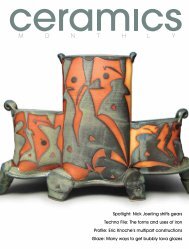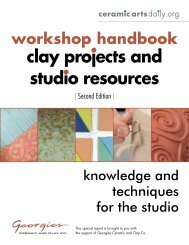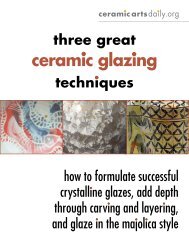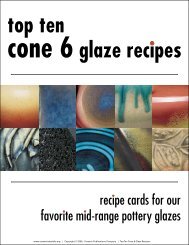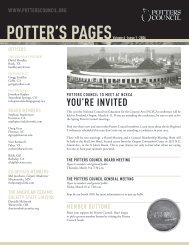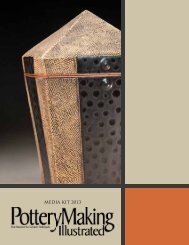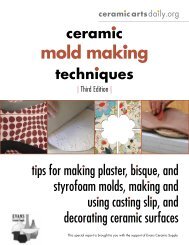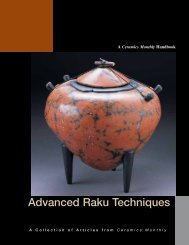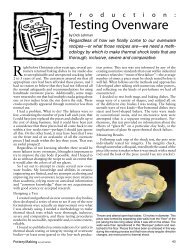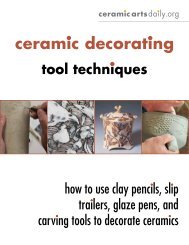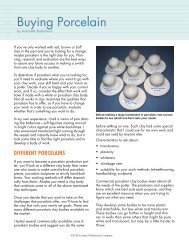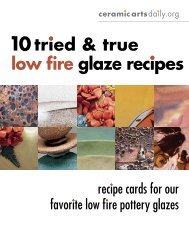Ceramic Sculpture - Ceramic Arts Daily
Ceramic Sculpture - Ceramic Arts Daily
Ceramic Sculpture - Ceramic Arts Daily
Create successful ePaper yourself
Turn your PDF publications into a flip-book with our unique Google optimized e-Paper software.
<strong>Ceramic</strong><br />
<strong>Sculpture</strong><br />
Edited by Anderson Turner<br />
Inspiring<br />
Techniques<br />
<strong>Ceramic</strong><br />
<strong>Arts</strong><br />
Handbook<br />
Series
<strong>Ceramic</strong><br />
<strong>Sculpture</strong><br />
i
Edited by Anderson Turner<br />
The American <strong>Ceramic</strong> Society<br />
600 N. Cleveland Ave., Suite 210<br />
Westerville, Ohio 43082<br />
www.<strong>Ceramic</strong><strong>Arts</strong><strong>Daily</strong>.org<br />
<strong>Ceramic</strong><br />
<strong>Sculpture</strong><br />
Inspiring<br />
Techniques<br />
<strong>Ceramic</strong><br />
<strong>Arts</strong><br />
Handbook<br />
Series
<strong>Ceramic</strong> <strong>Arts</strong> Handbook<br />
iv<br />
The American <strong>Ceramic</strong> Society<br />
600 N. Cleveland Ave., Suite 210<br />
Westerville, OH 43082<br />
© 2009, 2011 by The American <strong>Ceramic</strong> Society, All rights reserved.<br />
ISBN: 978-1-57498-300-5 (Paperback)<br />
ISBN: 978-1-57498-530-6 (PDF)<br />
No part of this book may be reproduced, stored in a retrieval system or transmitted<br />
in any form or by any means, electronic, mechanical, photocopying, microfilming,<br />
recording or otherwise, without written permission from the publisher, except by a<br />
reviewer, who may quote brief passages in review.<br />
Authorization to photocopy for internal or personal use beyond the limits of Sections<br />
107 and 108 of the U.S. Copyright Law is granted by The American <strong>Ceramic</strong> Society,<br />
provided that the appropriate fee is paid directly to the Copyright Clearance Center,<br />
Inc., 222 Rosewood Drive, Danvers, MA 01923 U.S.A., www.copyright.com. Prior<br />
to photocopying items for educational classroom use, please contact Copyright<br />
Clearance Center, Inc. This consent does not extend to copyright items for general<br />
distribution or for advertising or promotional purposes or to republishing items<br />
in whole or in part in any work in any format. Requests for special photocopying<br />
permission and reprint requests should be directed to Director, Publications, The<br />
American <strong>Ceramic</strong> Society, 600 N. Cleveland Ave., Westerville, Ohio 43082 USA.<br />
Every effort has been made to ensure that all the information in this book is accurate.<br />
Due to differing conditions, equipment, tools, and individual skills, the publisher<br />
cannot be responsible for any injuries, losses, and other damages that may result<br />
from the use of the information in this book. Final determination of the suitability of<br />
any information, procedure or product for use contemplated by any user, and the<br />
manner of that use, is the sole responsibility of the user. This book is intended for<br />
informational purposes only.<br />
The views, opinions and findings contained in this book are those of the author. The<br />
publishers, editors, reviewers and author assume no responsibility or liability for<br />
errors or any consequences arising from the use of the information contained herein.<br />
Registered names and trademarks, etc., used in this publication, even without specific<br />
indication thereof, are not to be considered unprotected by the law. Mention of trade<br />
names of commercial products does not constitute endorsement or recommendation<br />
for use by the publishers, editors or authors.<br />
Publisher: Charles Spahr, President, <strong>Ceramic</strong> Publications Company, a wholly owned<br />
subsidiary of The American <strong>Ceramic</strong> Society<br />
Art Book Program Manager: Bill Jones<br />
Series Editor: Anderson Turner<br />
Graphic Design and Production: Melissa Bury, Bury Design, Westerville, Ohio<br />
Cover Images: “Immersion 17” by Kathy Venter; (top right) “Spheres with Cross” by<br />
Barbro Åberg; (bottom right) “Floating Slabs Teapot” by Louis Marak<br />
Frontispiece: “Spiked Log” by Mark Gordon
Contents<br />
George McCauley: Life Experiences 1<br />
Peter Held<br />
Jim Koudelka: Layered Contraptions 7<br />
Daniel Duford<br />
Reflections on Accumulation 14<br />
Wendy Walgate<br />
Greg Penner: Casting Call 19<br />
Braden Frieder<br />
Growth in Change 23<br />
Mark Chatterley<br />
Adrian Arleo: Nature Studies 29<br />
Marnie Prange<br />
Jean-Pierre Larocque: Heads and Horses 37<br />
Andy Nasisse<br />
Immersion Series 44<br />
Kathy Venter<br />
Spraying Paper-Reinforced Clay 49<br />
W. Lowell Baker<br />
Paper Clay and Steel 53<br />
Linda Mau<br />
Barbro Åberg: Lightweight <strong>Sculpture</strong> 56<br />
Ulla Munck Jørgensen<br />
Gary Erickson: Organic Abstraction 61<br />
Andrea Myklebust<br />
Eva Kwong: Sculptural Vases 67<br />
Kate Bonansinga<br />
Kathleen Holmes: Dress <strong>Sculpture</strong>s 71<br />
Barbara Rizza Mellin
Slip-coated Fabric 74<br />
Jen Champlin<br />
Leigh Taylor Mickelson: Stacked Compositions 77<br />
Mary K. Cloonan<br />
Tile and <strong>Sculpture</strong> 81<br />
Niel Amon<br />
Right Angle Jig 87<br />
Marcia Selsor<br />
Sheri Leigh: Large-scale Slab <strong>Sculpture</strong>s 89<br />
Morgan Britt<br />
Saggar-fired <strong>Sculpture</strong>s 96<br />
Mee-Kyung Nam<br />
Mortar Construction 99<br />
Mark Gordon<br />
Patrick Crabb: Adobe Castings 103<br />
George M. Tapley Jr.<br />
Deirdre McLoughlin: Coiling Around Space 106<br />
Nesrin During<br />
Figurative Soft-Slab <strong>Sculpture</strong> 109<br />
Dee Schaad<br />
Louis Marak: Illusionary <strong>Sculpture</strong> 113<br />
Cathy Ray Pierson<br />
Catrin Mostyn Jones: Doing What Comes Naturally 118<br />
Alex McErlain<br />
Mary Fischer: Slab-built Structures 121<br />
Jim LaVilla-Havelin<br />
Rapid Prototyping 124<br />
Steven Thurston<br />
Nina Hole: Site-fired Kiln <strong>Sculpture</strong> 130<br />
Glen R. Brown
Preface<br />
As an artist, educator and gallery director, I’ve spent many hours looking at<br />
and thinking about art and art making. Often I’m looking for inspiration for<br />
my own work or for a curatorial idea I have brewing. Many times I’ve sent students<br />
to look someone up, so they can better understand the artist’s ideas and<br />
techniques in order to better inform their own work.<br />
This book is a great tool for exactly that process. From beginning to end it<br />
contains details about the making process. As a gallery director I’m forever reintroducing<br />
patrons to people and ideas that everyone should hold dear. While<br />
in my own art I may stick to a certain aesthetic, as an educator/curator I find,<br />
as I grow older, a fondness for all art making. Most importantly I feel my students<br />
and patrons often lack an understanding of the value of their education<br />
and are more worried about what it can get them than what they can learn.<br />
I also feel strongly that art making is a research driven activity. The information<br />
contained in this book is written by some of the more innovative and<br />
interesting minds working in ceramics today. While not all of the ideas are<br />
necessarily groundbreaking, they are unique in their individual approach to<br />
the use of the material. How these artists researched and successfully used the<br />
processes they set out to is inspirational, informative and important. I hope<br />
you find the research contained in these pages as exciting as I do.<br />
Anderson Turner<br />
<strong>Ceramic</strong><br />
<strong>Sculpture</strong><br />
vii
George McCauley<br />
Life Experiences<br />
by Peter Held<br />
Through their work, artists<br />
communicate a full range<br />
of emotions, perceptions<br />
and spiritual explorations. George<br />
McCauley shapes these varied life<br />
experiences into clay forms that are<br />
assembled as wholly personal and revealing<br />
sculpture. Prior to studying<br />
art, his vocational positions included<br />
carpenter, concrete inspector, waiter<br />
and chef, mechanic, horse trainer<br />
and aluminum-siding salesman.<br />
Like many of his contemporaries,<br />
McCauley was drawn to clay after<br />
his initial introduction, a classic case<br />
of the “love at first touch” syndrome.<br />
Ron Meyers at the University of<br />
Georgia, was a significant role model.<br />
At the University of South Carolina,<br />
Meyers fostered an environment of<br />
experimental freedom, instilling in<br />
McCauley a sense of discovery and<br />
excitement for the medium.<br />
The work of Peter Voulkos<br />
also has been a strong influence.<br />
“Voulkos works as if the pieces come<br />
out of him, not by him,” observes<br />
McCauley. “His devotion to making<br />
art, breaking new ground and<br />
his abilities to make works that are<br />
about what he wants to make are<br />
Candelabrum, 43 inches in height, wheel-thrown<br />
and handbuilt earthenware, soda fired.<br />
<strong>Ceramic</strong><br />
<strong>Sculpture</strong><br />
1
<strong>Ceramic</strong> <strong>Arts</strong> Handbook<br />
2<br />
McCauley hand trimming excess<br />
clay from thrown shapes prior to<br />
assemblage.<br />
in spirational. The seemingly casual<br />
appearance and freedom evident in<br />
his work are what I strive for in my<br />
own creative endeavors.”<br />
George Ohr’s persona and art also<br />
hold a particularly strong fascination<br />
for McCauley. Billing himself<br />
as the “Mad Potter of Biloxi,” Ohr<br />
was a nonconformist who created a<br />
distinctive body of work that challenged<br />
the status quo of the day.<br />
Both McCauley and Ohr share a hirsute<br />
sensibility as well, sporting ample<br />
mustaches reflecting flamboyant<br />
personalities.<br />
Having spent the greater part of<br />
his childhood residing in Georgia and<br />
South Carolina, McCauley absorbed<br />
the rich history of folk-art traditions<br />
of the South, particularly those of<br />
the Jugtown potters. For a time, he<br />
emulated these artists—inhabiting<br />
a rustic home in the country, surrounded<br />
by yard art and integrating<br />
his creative endeavors with the art<br />
of everyday living. “I have fancied<br />
myself as a kind of folk artist, not<br />
as a primitive or naïve practitioner,<br />
but relating to the complete sense<br />
of freedom in their work. Folk artists<br />
make what they want to make<br />
and create their art completely from<br />
within.”<br />
Myths and archetypal symbols,<br />
some relating to his childhood growing<br />
up in a strict Greek Orthodox<br />
home, play a significant role in<br />
McCauley’s work. He has a strong interest<br />
in the rituals and ceremonies<br />
found in world cultures. He is fascinated<br />
with religious objects such<br />
as icons, shrines and vestments.<br />
Universal symbols—concentric life<br />
spirals, the mati (an open palm with<br />
an eye)—are incorporated in his<br />
work to express needs or desires.<br />
This implies a personal narrative<br />
invoking historical significance.<br />
Compositionally, McCauley is<br />
drawn to an unconventional organization<br />
of objects, disturbing juxtapositions<br />
and, at times, fantastic<br />
extravagance. Fleshy figures cavort<br />
with a menagerie of barnyard animals,<br />
fish, a jumble of cups, saucers<br />
and other miniature pots. He interweaves<br />
dopey-eyed reptiles suffering<br />
from heatstroke in the arid desert<br />
and skeletal remains on cylindrical<br />
candlesticks. His totemic candelabra<br />
and house sculptures are similar to<br />
trees of life, a marriage between the<br />
animal and human worlds.
Covered jar, 26 inches in height, earthenware, iron wash and glaze, soda fired.<br />
photos: george mccauley, craig sharpe<br />
<strong>Ceramic</strong><br />
<strong>Sculpture</strong><br />
3
<strong>Ceramic</strong> <strong>Arts</strong> Handbook<br />
4<br />
Wall sconce, 21 inches in height, wheel-thrown and handbuilt earthenware, with<br />
terra sigillata, soda fired to cone 02.<br />
There is a narrative quality to<br />
the work, begging for a story to unfold.<br />
McCauley denies any strict<br />
interpretation, but, rather, places<br />
a deeper importance on the meaning<br />
of the subject matter. “My work<br />
is narrative in the sense that I am<br />
saying something about my feelings,<br />
not always telling a story.”<br />
Some of the relationships impart<br />
humor, at times salacious, and he<br />
feels this is a good enough reason to<br />
create.<br />
A freedom of process, where revisions<br />
and changes are evident, not<br />
hidden or refined to the point of obscuring<br />
the hand of the maker, also<br />
appeals to McCauley. “I am process<br />
oriented in most of my endeavors.<br />
The act of making and the vitality of<br />
the construction are very important<br />
to me. I alter my work when it is soft
so that I can keep all the nuances of<br />
the construction—I want the working<br />
process to remain evident in feeling<br />
and posture. Techniques have<br />
become less important as the years<br />
go by—giving way to a looser method<br />
of working.”<br />
McCauley is primarily concerned<br />
with the making of objects, so his<br />
work is mostly wheel thrown, then<br />
altered and accented with handbuilt<br />
additions. Earthenware best suits<br />
his needs, and “soda firing completes<br />
the soft, sensual feel I strive for.”<br />
Most of his glazes are cone 10 reduction<br />
recipes that are fired in the<br />
cone 08–02 range in a soda or vapor<br />
atmosphere, as well as in an electric<br />
kiln. The dry and irregular surfaces<br />
enhance the imagery. Some of his<br />
works, particularly those with hues<br />
of purple and deep blue, take on an<br />
apocalyptic cast, looking like postnuclear<br />
relics.<br />
The color palette is generally<br />
muted. Some of his glazing strategies<br />
include undercoating with slips<br />
and terra sigillatas on leather-hard<br />
or bisqued surfaces, then pouring<br />
glaze overall and wiping off most.<br />
Occasionally, he simply applies a<br />
kaolin wash, then fires to cone 02 in<br />
a soda kiln. Other times after firing,<br />
a sprinkling of dry glaze, dirt or grog<br />
is applied, and the work refired.<br />
Fundamentals and technique are<br />
merely a means to an end. McCauley<br />
chooses to do whatever is necessary,<br />
disregarding efficiency or practicality<br />
over a path that will achieve<br />
the results that best reflect his<br />
sensibilities.<br />
Candlestick, approximately 30 inches<br />
in height, soda-fired earthenware,<br />
by George McCauley.<br />
McCauley has concentrated on<br />
creating a body of work composed<br />
of personal statements and expressions<br />
about a life dedicated to the<br />
creative act. His sculptures convey<br />
the idea that a magical dimension<br />
of life—partly lost in the rush of<br />
modernity—can be recaptured and<br />
embraced without hesitation.<br />
<strong>Ceramic</strong><br />
<strong>Sculpture</strong><br />
5
<strong>Ceramic</strong> <strong>Arts</strong> Handbook<br />
6<br />
Recipes<br />
Blood on the Saddle Earthenware<br />
Cone 08–02<br />
Custer Feldspar . . . . . . . . . . . . 7 .9 %<br />
Ball Clay . . . . . . . . . . . . . . . . . 11 .9<br />
Carbondale Clay . . . . . . . . . . . 39 .6<br />
Fireclay . . . . . . . . . . . . . . . . . . 29 .7<br />
Grog . . . . . . . . . . . . . . . . . . . . 10 .9<br />
100 .0 %<br />
Add 25% Cedar Heights Redart for a darker body<br />
to be used in oxidation .<br />
Green Barium Matt Glaze<br />
Blue Barium Matt Glaze<br />
Cone 10<br />
Barium Carbonate . . . . . . . . . . 40 %<br />
Spodumene . . . . . . . . . . . . . . . 10<br />
Nepheline Syenite . . . . . . . . . . 45<br />
Silica . . . . . . . . . . . . . . . . . . . . 5<br />
100 %<br />
Add: Black Copper Oxide . . . . . 4 %<br />
Bentonite . . . . . . . . . . . . 2 %<br />
For a green variation, replace the copper oxide<br />
with 5% iron oxide .<br />
Cone 10<br />
Barium Carbonate . . . . . . . . . . 37 .3 %<br />
Nepheline Syenite . . . . . . . . . . 48 .1<br />
Ball Clay . . . . . . . . . . . . . . . . . 7 .1<br />
Silica . . . . . . . . . . . . . . . . . . . . 7 .5<br />
100 .0 %<br />
Add: Black Copper Oxide . . . . . 2 .0 %<br />
Bentonite . . . . . . . . . . . . 2 .0 %<br />
Purple Barium Matt Glaze<br />
Cone 10<br />
Barium Carbonate . . . . . . . . . . 36 .5 %<br />
Nepheline Syenite . . . . . . . . . . 44 .2<br />
Ball Clay . . . . . . . . . . . . . . . . . 9 .9<br />
Silica . . . . . . . . . . . . . . . . . . . . 9 .4<br />
100 .0 %<br />
Add: Copper Carbonate . . . . . . 3 .0 %<br />
When using barium compounds, be aware of the<br />
toxic nature of this chemical . Always wear a respi-<br />
Bentonite . . . . . . . . . . . . 2 .0 %<br />
rator and gloves when mixing glazes . To avoid the<br />
barium risk, McCauley has begun to substitute<br />
Green Glaze<br />
strontium carbonate for barium carbonate in a<br />
ratio of ¾ to 1 .<br />
Cone 08–6<br />
Barium Carbonate . . . . . . . . . . 22 .2 %<br />
Gerstley Borate . . . . . . . . . . . . 11 .1<br />
G-200 Feldspar . . . . . . . . . . . . 44 .4<br />
EPK Kaolin . . . . . . . . . . . . . . . . 11 .2<br />
Silica . . . . . . . . . . . . . . . . . . . . 11 .1<br />
100 .0 %<br />
Add: Zinc Oxide . . . . . . . . . . . . 11 .0 %<br />
Copper Carbonate . . . . . . 10 .5 %<br />
Bentonite . . . . . . . . . . . . 2 .0 %<br />
White Glaze<br />
Cone 08–1<br />
Ferro Frit 3124 . . . . . . . . . . . . . 75 %<br />
Ball Clay . . . . . . . . . . . . . . . . . 25<br />
100 %<br />
Add: Opax . . . . . . . . . . . . . . . . 18 %<br />
Bentonite . . . . . . . . . . . . 2 %<br />
Mottled Brown Glaze<br />
Cone 08–6<br />
Ash . . . . . . . . . . . . . . . . . . . . . 13 .0 %<br />
Gerstley Borate . . . . . . . . . . . . 52 .2<br />
Alberta Slip Clay . . . . . . . . . . . 34 .8<br />
100 .0 %<br />
Terra Sigillata<br />
Clay . . . . . . . . . . . . . . . . . . . . 6 lb<br />
Water . . . . . . . . . . . . . . . . . . . 15<br />
21 lb<br />
Mix 50 grams sodium silicate into the water, then<br />
add the clay . Decant mixture for 24 hours; siphon<br />
off water . Lift out the top layer of slip with hands .<br />
Yields 1 quart of thick slip . For application, thin<br />
with additional water . Variations include adding<br />
5% Gerstley borate without decanting, colored<br />
stains added by eye, or using throwing water .



